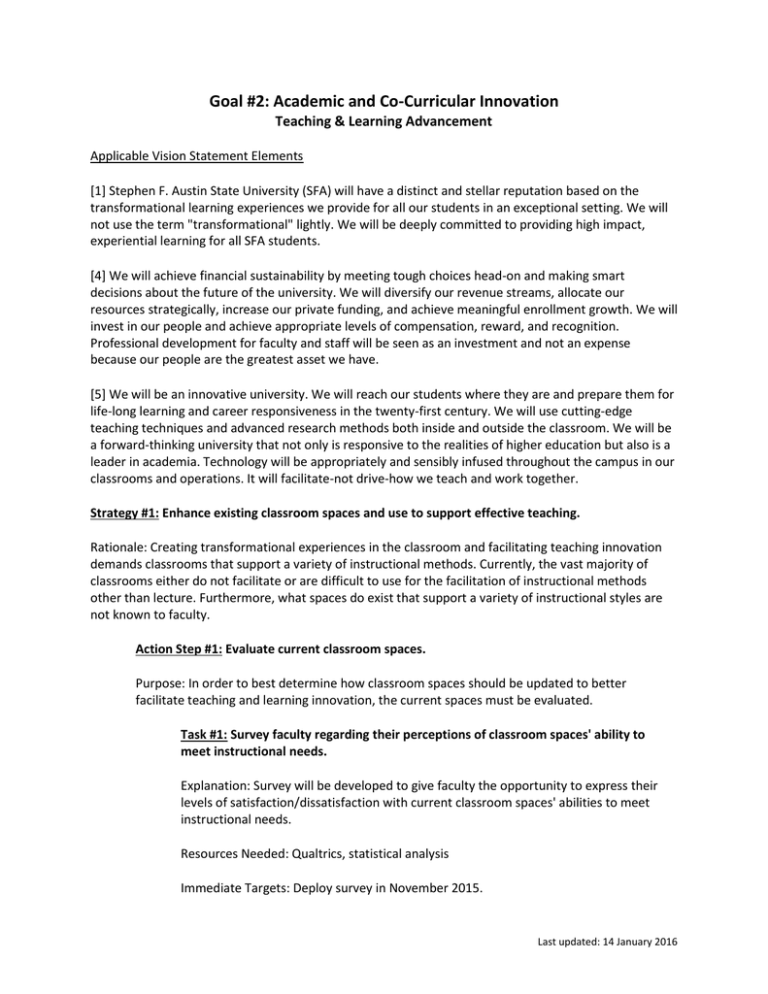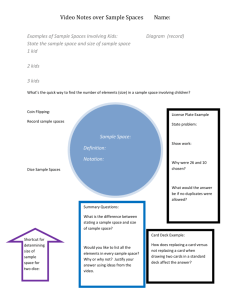Goal #2: Academic and Co-Curricular Innovation Teaching & Learning Advancement
advertisement

Goal #2: Academic and Co-Curricular Innovation Teaching & Learning Advancement Applicable Vision Statement Elements [1] Stephen F. Austin State University (SFA) will have a distinct and stellar reputation based on the transformational learning experiences we provide for all our students in an exceptional setting. We will not use the term "transformational" lightly. We will be deeply committed to providing high impact, experiential learning for all SFA students. [4] We will achieve financial sustainability by meeting tough choices head-on and making smart decisions about the future of the university. We will diversify our revenue streams, allocate our resources strategically, increase our private funding, and achieve meaningful enrollment growth. We will invest in our people and achieve appropriate levels of compensation, reward, and recognition. Professional development for faculty and staff will be seen as an investment and not an expense because our people are the greatest asset we have. [5] We will be an innovative university. We will reach our students where they are and prepare them for life-long learning and career responsiveness in the twenty-first century. We will use cutting-edge teaching techniques and advanced research methods both inside and outside the classroom. We will be a forward-thinking university that not only is responsive to the realities of higher education but also is a leader in academia. Technology will be appropriately and sensibly infused throughout the campus in our classrooms and operations. It will facilitate-not drive-how we teach and work together. Strategy #1: Enhance existing classroom spaces and use to support effective teaching. Rationale: Creating transformational experiences in the classroom and facilitating teaching innovation demands classrooms that support a variety of instructional methods. Currently, the vast majority of classrooms either do not facilitate or are difficult to use for the facilitation of instructional methods other than lecture. Furthermore, what spaces do exist that support a variety of instructional styles are not known to faculty. Action Step #1: Evaluate current classroom spaces. Purpose: In order to best determine how classroom spaces should be updated to better facilitate teaching and learning innovation, the current spaces must be evaluated. Task #1: Survey faculty regarding their perceptions of classroom spaces' ability to meet instructional needs. Explanation: Survey will be developed to give faculty the opportunity to express their levels of satisfaction/dissatisfaction with current classroom spaces' abilities to meet instructional needs. Resources Needed: Qualtrics, statistical analysis Immediate Targets: Deploy survey in November 2015. Last updated: 14 January 2016 Long-Range Targets: Use survey information to aid in the identification of classroom upgrade priorities. Impacted Departments: All academic departments. Task #2: Survey students regarding their perceptions of classroom spaces and learning experiences. Explanation: Survey will be developed to give faculty the opportunity to express their levels of satisfaction/dissatisfaction with current classroom spaces' abilities to meet instructional needs. Resources Needed: Qualtrics, statistical analysis Immediate Targets: Deploy survey in spring 2016. Long-Range Targets: Use survey information to aid in the identification of classroom upgrade priorities. Impacted Departments: All academic departments. Task #3: Itemize furnishings and teaching tools in current classroom spaces. Explanation: To best understand which spaces have furnishings and teaching tools that facilitate the faculty's desired instructional methods, an inventory of furnishings and tools in classrooms must be conducted. Rooms most used will be inventoried first. Having this inventory also allows university to identify where low-cost solutions could have potentially significant impact and where significant capital infusions will be required. Resources Needed: student-worker to conduct inventory, database Immediate Targets: Complete bulk of inventory prior to beginning of spring 2016 classes. Long-Range Targets: Complete entire inventory by end of summer 2016. Impacted Departments: All academic departments. Task #4: Identify and prioritize needs in all classrooms. Explanation: Armed with data from the faculty survey and the spaces inventory, needs assessment will be created and prioritized. The goal is to bring classrooms up to a minimum standard of function and utility. Resources Needed: Individual(s) to evaluate data Last updated: 14 January 2016 Immediate Targets: Complete needs assessment by end of spring 2016. Long-Range Targets: N/A Impacted Departments: N/A Action Step #2: Use findings in faculty and student surveys to update classroom spaces. Purpose: Once needs are identified, it is imperative that the university take action to being to update classroom spaces. Doing so aids faculty and students by providing spaces conducive to teaching and learning. Task #1: Complete five tech-enhanced classrooms by providing flexible furniture and (where appropriate) new flooring. Explanation: In summer 2015, five classrooms were brought offline and upgraded with new technologies. However, these rooms are not currently being used at optimum efficiency because their furniture does not easily facilitate instructional methods other than lecture. Resources Needed: HEAF funds to upgrade furniture Immediate Targets: Select and order furniture by March 2016. Long-Range Targets: Complete room upgrades/furniture assembly and placement before beginning of Fall 2016. Impacted Departments: Any department with faculty wishing to teach in these five classrooms. Task #2: Update highest priority needs in all classrooms by the end of FY 2016. Explanation: The faculty survey (and in the future, hopefully the classroom issues form...see below) brought to light several issues that need to be rectified as soon as possible (e.g. broken chairs). Any HEAF funds left over following the upgrade of furnishings in the five classrooms should be allocated to correcting these issues. Resources Needed: HEAF funds, room inventory results Immediate Targets: Complete upgrades by end of FY 2016. Long-Range Targets: N/A Impacted Departments: All academic departments. Task #3: Secure annual budget allocations for ongoing upgrades to classroom spaces. Last updated: 14 January 2016 Explanation: Without an annual fiscal commitment to updating classroom spaces, the above tasks are a mere Band-Aid. We recommend that the university dedicate at least $500,000 annually to the task of upgrading existing classroom spaces. Resources Needed: Annual fiscal resources Immediate Targets: Secure $350,000 in HEAF funds for classroom upgrades for FY 2017. Long-Range Targets: Secure annual allocation of at least $500,000 for classroom upgrades. Impacted Departments: All academic departments. Action Step #3: Develop effective two-way communication between institution and faculty regarding the availability and functionality of classroom spaces. Purpose: By communicating to faculty the resources available in individual classroom spaces, we provide faculty with the opportunity to request that they be able to teach in spaces that foster teaching and learning innovation. Furthermore, by providing faculty with the opportunity to report classroom-related issues, we can at least provide basic maintenance of spaces. Task #1: Effectively communicate to faculty the resources and tools that exist in current classroom spaces. Explanation: This includes sending emissaries to departments and faculty regarding the availability of a new inventory of classroom spaces and tools, creating an inventory of classroom spaces and tools, and creating an interactive map showcasing spaces and tools. Resources Needed: student-workers to create inventory of classroom spaces, human resources to make that information available online in database and graphical (map) format. Immediate Targets: By end of summer 2016, place inventory data online, and send multiple communiques to faculty (via various methods) letting them know that the information is available to them. Long-Range Targets: Create interactive map that includes inventory data by spring 2017. Impacted Departments: Center for Teaching & Learning, ITS Task #2: Create an online system for reporting classroom infrastructure issues that impede learning such as broken furniture, technology, temperature, lighting, etc. Last updated: 14 January 2016 Explanation: Faculty need a way to report to the institution those items requiring attention in their classrooms. Doing so makes appropriate individuals aware of items requiring attention and helps administrators plan for future replacement costs. Resources Needed: Online form Immediate Targets: Place form online by end of spring 2016 and make faculty aware of its availability and location. Long-Range Targets: Maintain form indefinitely. Impacted Departments: ITS, Center for Teaching & Learning Action Step #4: Work with design center to inventory furniture available on campus that is designated as flexible or has the ability to be updated (i.e. by adding casters). Strategy #2: Enhance effective instruction through professional development. This and additional strategies to be further developed in Spring 2016. Last updated: 14 January 2016





